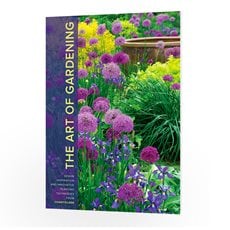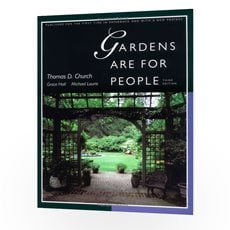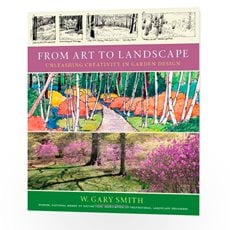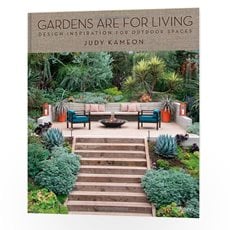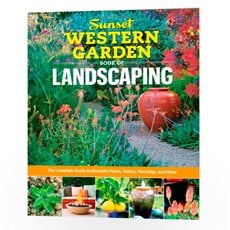Landscape Design Principles for Residential Gardens
Eight rules for creating a satisfying garden that is neither fussy nor constrainingIt’s tempting, in a field as subjective as garden design, to feel that rules do not apply. However, after 28 years and hundreds of projects later, I’ve come to believe in certain rules and guidelines that are neither fussy nor constraining. All have proven invaluable to me over my years of garden-making. Applied by any gardener, amateur or professional, they will result in a more successful, satisfying design.
Free newsletter with garden design tips every Thursday!
Let’s start with two rules that can kick-start the process of laying out a landscape, then move on to guidelines that help in scaling the proportions of a garden’s elements and, finally, to choosing and using the right plants.
01: OBEY THE "LAW" OF SIGNIFICANT ENCLOSURE
Yes, this one’s a “law,” not just a rule! It addresses the root meaning of garden, which is “enclosure.” This, to me, is absolutely critical in creating a sense of refuge and of feeling oneself within nature’s embrace. The law of significant enclosure says that we feel enclosed when the vertical edge of a space is at least one-third the length of the horizontal space we’re inhabiting. Probably derived from behavioral psychology studies, this rule came to me from a professor in graduate school, and it was one of the best things I learned.
Just yesterday, as I was starting the design of a patio that I wanted to separate from an adjacent play area, it gave me instant guidance for how tall a hedge I would need: the area was 17 feet wide, and so my hedge should be at least 6 feet. Sit near a tree in the park, or a wall, and gradually edge away, and you’ll see how it works. Of course, there are times when the point of a landscape design is a monumental sense of scale or view, but the best gardens, whatever their size, modulate a feeling of enclosure and openness, and this rule will help.
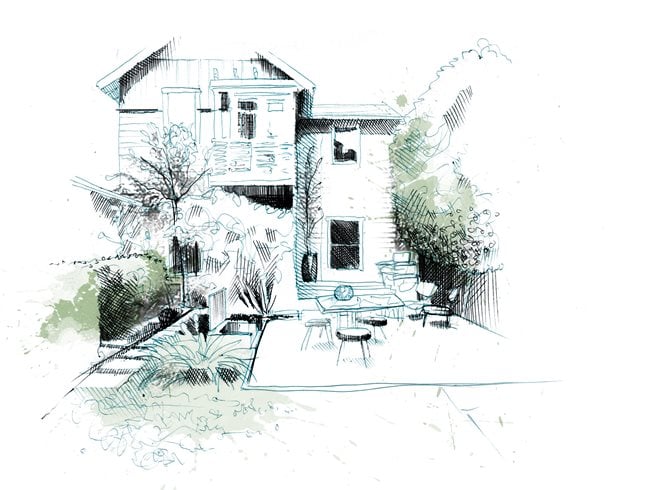
On this project in Pacific Palisades, CA, an existing and overgrown row of ficus was reduced by half knowing it would still more than adequately enclose the patio. Illustration by David Despau.
02: FOLLOW THE REGULATING LINE
My formal architectural education also introduced me to the concept of the “regulating line.” The idea is that an element of architecture (for example, a doorway, or a building edge, even a window mullion) or a distinctive landscape feature (prominent tree, existing pool, property boundary) can “generate” an imaginary line that helps connect and organize the design. For example, in laying out one backyard, I projected the lines of its building addition into the garden space and then aligned the swimming pool and wooden walkway with those lines. The result is orderly and cohesive, even after being softened with planting. “A regulating line,” wrote the great architect (and theoretician) Le Corbusier, “is an assurance against capriciousness…It confers on the work the quality of rhythm…The choice of a regulating line fixes the fundamental geometry of the work....”
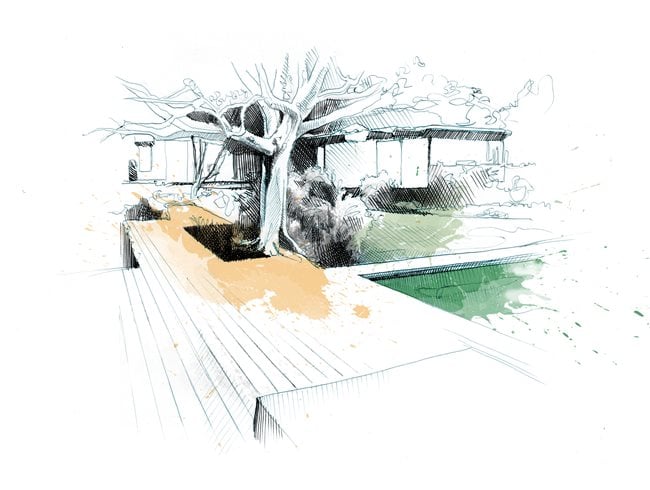
The decking on a different project in Pacific Palisades, CA, creates a regulating line that is parallel to the plane create by the gray wall of the house in the upper right of the image. Another regulating line is created by the edge of the pool running parallel to the glass window on the home. These lines intersect at the base of the tree. Illustration by David Despau.
Le Corbusier hits on the two aspects (a bit paradoxical, perhaps) that make the regulating line so valuable. First is the idea of underlying order: that the garden, for all its naturalness, or wildness, is founded on strong principles—what’s sometimes known in garden circles as “good bones.” Second, that regulating lines—at least as I employ them—are subjective; it’s the designer who identifies and manipulates them to create the garden. And I’d say that the use of the regulating line, more than any other concept, separates professional from amateur design.
Listen to this article
03: USE THE GOLDEN RECTANGLE TO GET PROPORTIONS RIGHT
Certain rules help us refine design. One is the Golden Ratio which is a ratio of proportion that’s been observed in everything from the Great Pyramids at Giza to the Greek Parthenon and has been used throughout history as a guide to a pleasing sense of balance and order. The practical application that I make of the Golden Ratio involves its sibling, the Golden Rectangle, in which the ratio of the short side to the long side is equal to the ratio of the long side to the sum of both sides (a/b = b/a+b)—you probably didn’t know that landscape architects had to learn math. Numerically, the Golden Rectangle ratio is close to 1: 1.6, a proportion I regularly use to lay out terraces, patios, arbors, and lawns. The raised beds in my vegetable garden are 5 by 8 feet. It’s a rectangular proportion that always looks good—they don’t call it golden for nothing!
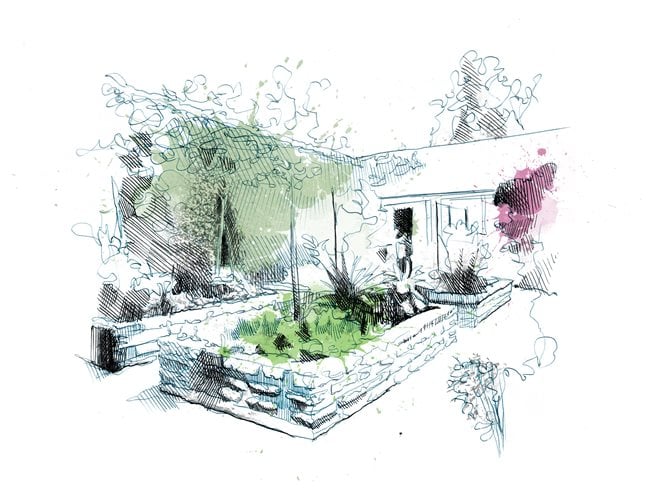
Raised planters in my garden follow the Golden Rectangle. Note, too, the significant enclosure provided by the Eugenia hedge. Illustration by David Despau.
04: TURN TO THOMAS D. CHURCH WHEN DESIGNING STEPS
Another ratio may even be platinum: That’s what I’ve always called the rule for step design advocated by landscape architect Thomas D. Church, often credited with creating the California style. Laid out in his seminal work Gardens Are for People, it says simply that twice the height of the riser plus the tread should equal 26 inches. That means that if the riser is 5 inches, the tread (what you walk on) should be 16 inches. All I can say is that the rule is true, and I’ve used it from steep canyon faces to gentle changes of patio levels. A useful corollary states that 5 feet is the minimum width for two people climbing steps side by side.
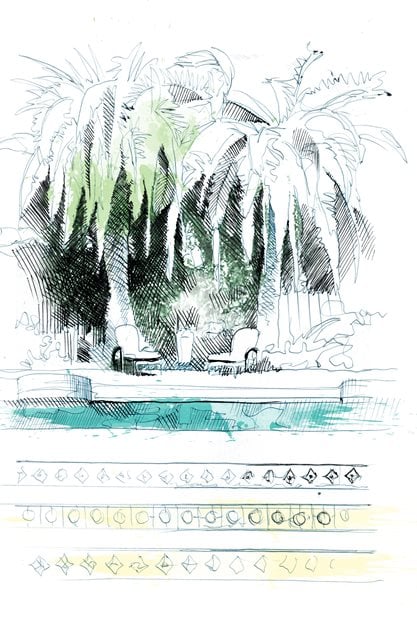
At this Mediterranean inspired garden in the Westwood neighborhood of Los Angeles, the tile-faced steps follow Church’s ratio. Illustration by David Despau.

05: SIZE MATTERS
A final rule related to scale and the sculpting of space is this: Go big. Faced with a decision to make a staircase wider or narrower, a pool longer or shorter, a pergola higher or lower, the answer is almost always the former. In my own garden, I remember laying out an arbor, with its posts 10 feet high, and listening to trusted friends wondering whether it wasn’t “a little too tall.” Thankfully I stuck to my guns, and some 18 years later, wreathed in wisteria and anchored at the ground by clusters of pots, the arbor seems just right.
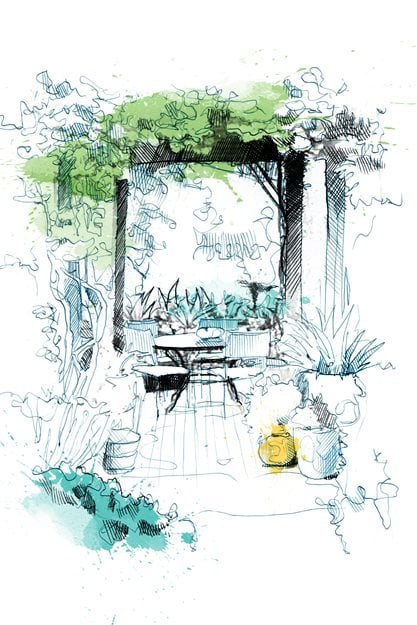
At ten feet, this arbor in my garden allows for hanging and surrounding foliage to intertwine and connect the arbor to the space without infringing on the sense of space. Illustration by David Despau.
06: PLANT BIG TO SMALL
It’s with plants, probably more than any other element of gardens, that the infinite variation and fickleness of nature is most evident—and so perhaps, they are the trickiest to prescribe rules for. And yet, successful planting is the crowning touch of a garden. Three rules have always served me well.
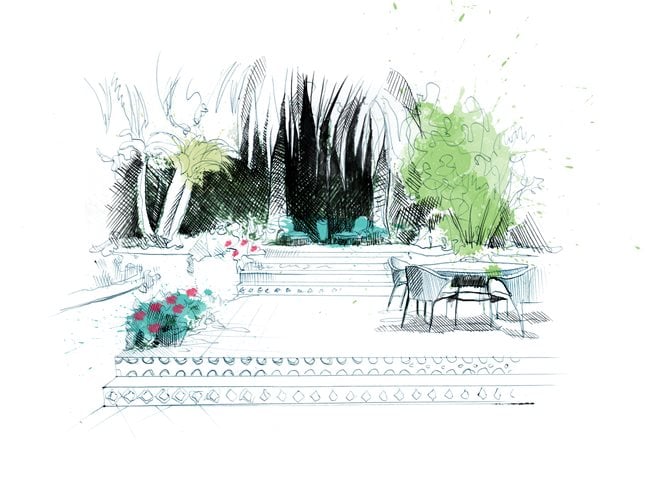
The big palms on this Mediterranean project were already on the property; the pepper tree followed. Then the hedges and vines were installed. Only after all this were the perennials and containers planted. Illustration by David Despau.
First, is to plant big to small: start with trees, then shrubs, then perennials, then ground cover. This is important not only in a compositional way (seeing the bigger forms first gives a better sense of the overall structure), but in a completely practical sense. Setting a big tree may require machinery or at least multiple gardeners and ample space for maneuvering and stationing amendments and soils; it would be sad to damage or undo some newly planted bed. This seems so obvious, but for lots of gardeners (the author included) a block of fresh perennials may be impossible to avoid planting right away. Be strong; resist the temptation.
07: PLANT IN MASSES
While there is much to be said for the cottage garden, with a rich array of varied planting (indeed, it’s the real master gardener who can pull this off), there is a power to seeing a quantity of one plant that is genuinely affecting. Russell Page, one of the great twentieth-century landscape designers said it well: “the most striking and satisfying visual pleasure comes from the repetition or the massing of one simple element. Imagine the Parthenon with each column a different kind of marble!”
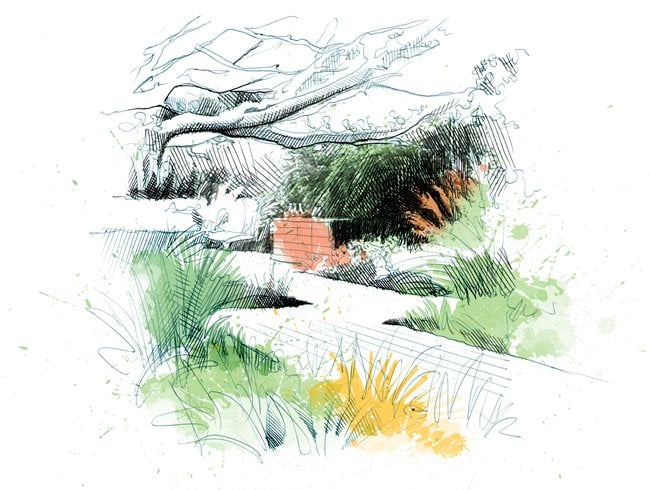
Ornamental grasses, Miscanthus sinensis ‘Morning Light’ and Sesleria autumnalis flank a garden boardwalk in Pacific Palisades, CA. Using drifts on both sides of the walk reinforces a sense of mass planting. Illustration by David Despau.
I remember as a beginning garden designer in California being taken aside by my mentor, a transplanted Englishwoman who owned the nursery, walking through a vast block of salvia, and being told that I could, if I liked, use 30 of them—not the three or five I’d typically been planting. It was a liberating moment.
08: REMEMBER THIS ABOVE ALL
Maybe my favorite rule of all time, all the more charming for its need to be adjusted for inflation: It’s better to plant a 50-cent plant in a $5 hole, than a $5 plant in a 50-cent hole. Imparted by Ralph Snodsmith, my first official gardening teacher at the New York Botanical Garden and talk radio host (a character whose working uniform was always a forest green three-piece suit), there is no greater planting wisdom. No matter how brilliant a plan one conceives, if the plants are not well planted—at the right height, in a sufficiently sized, and properly amended pit—the results will likely be poor. Some rules just can’t be broken.
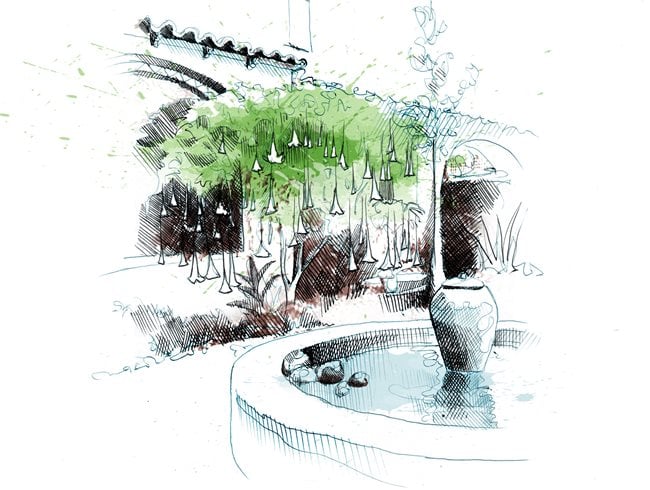
On yet another project in Pacific Palisades, CA, I planted a Brugmansia versicolor (angel's trumpet). This plant had been banging around in the back of my truck for weeks so I asked the client if they wanted it. With a well-dug and amended hole, it flourished. Illustration by David Despau.
Recommended Landscape Design Resources
The books shown here are Garden Design editor favorites.
ABOUT THE AUTHORGardens are such personal and individual expressions that the very idea that there is a “way” to create one seems almost insane. And the range of prescriptions about how it should be done—from conventional wisdom such as planting tall plants in the back of the border and short ones in front, to the ironclad strictures of codes, covenants, and restrictions—will stir the rebel impulse in any creative soul. Faced with a building code that dictates a 42-inch limit on planting, I will make it a point of honor to go higher. I am all for a healthy anarchistic impulse in the garden.
But I am also formally trained, the product of a prestigious East Coast graduate landscape architecture program—deemed ready to design gardens when I moved west to Los Angeles to begin my career. In fact, as I see it now, I knew only a few things then, and those in a largely theoretical way. What’s more, my knowledge was to be tested and often subverted in my new environment. Everything was different: plants, climate, construction technologies—everything. The first time I saw eucalyptus trees hacked into coat-racks of stubs and stumps, I remember thinking “maybe that’s how they’re supposed to be pruned.” (I got that sorted pretty quickly.) It was some years later—working first in a large office, then in a wonderful nursery where I got an intensive course in appropriate planting for Southern California—that I migrated towards residential garden design. There, personal involvement seemed the highest, and the experience of landscape the most intimate—just the thing that had drawn me to the field in the first place.
RELATED:
10 Essential Elements and Principles of Landscape Design
See how these tips fit into a full outdoor plan—visit our Landscape Design hub for more expert advice.
Read about five more landscape design rules on LandscapingNetwork.com.
This article, adapted for the web, originally appeared in the Early Spring 2015 issue of Garden Design Magazine under the title "Rules of the Game."

